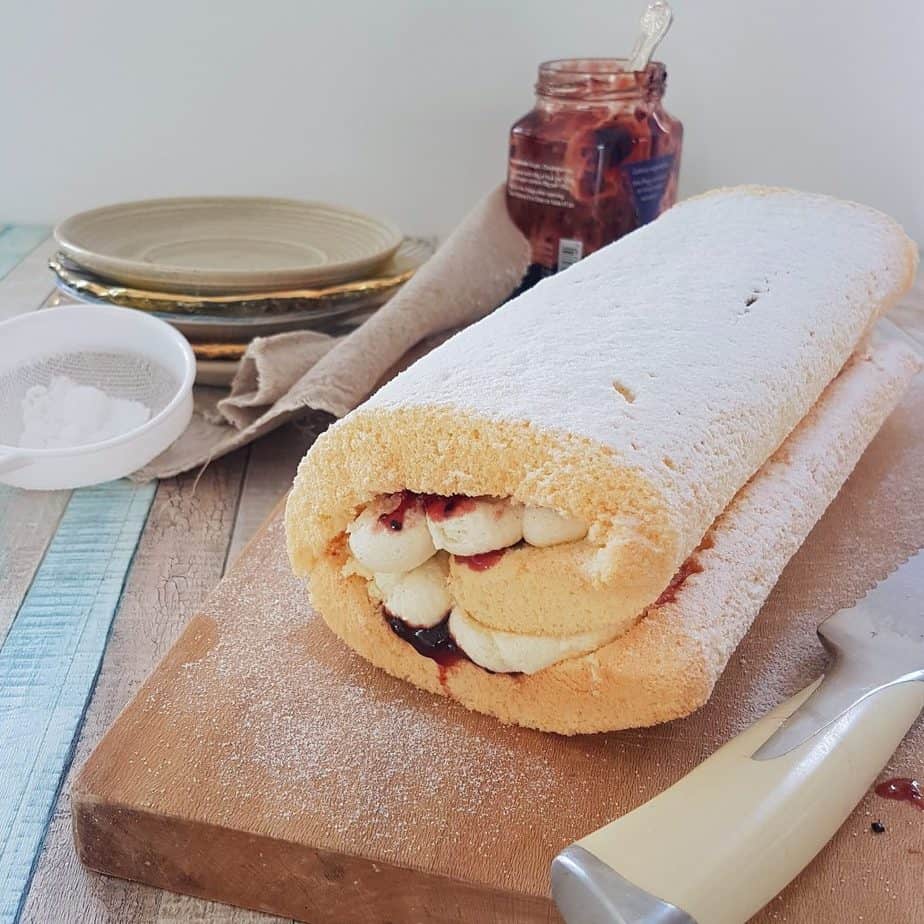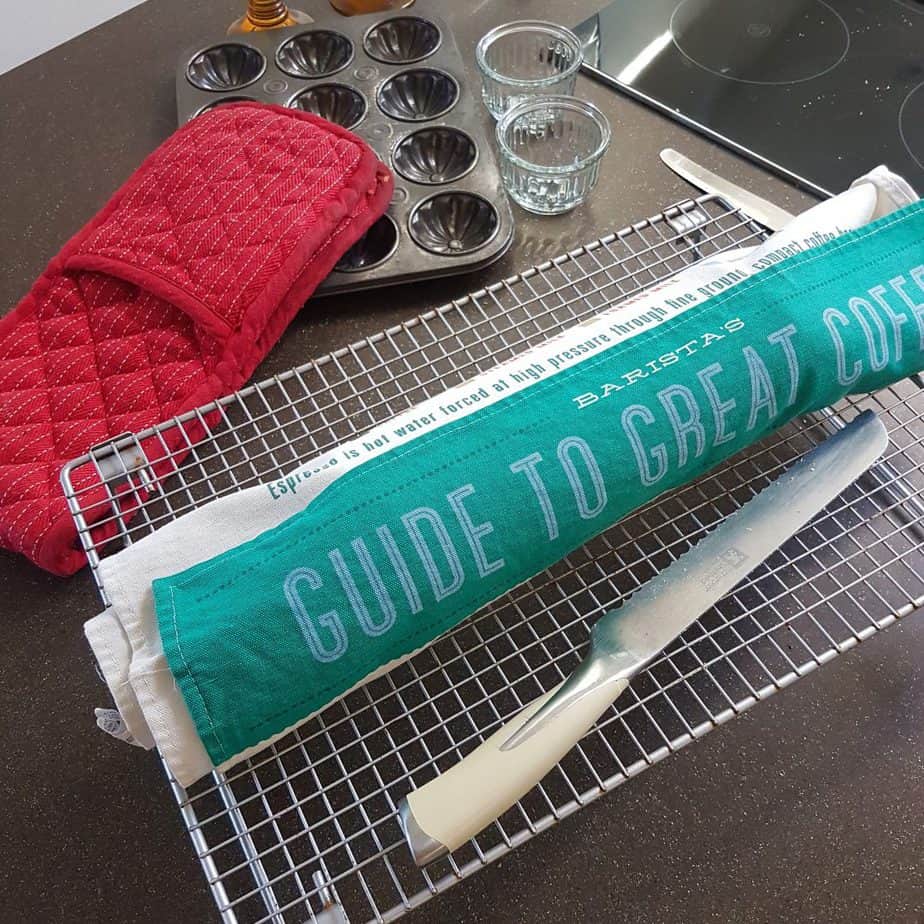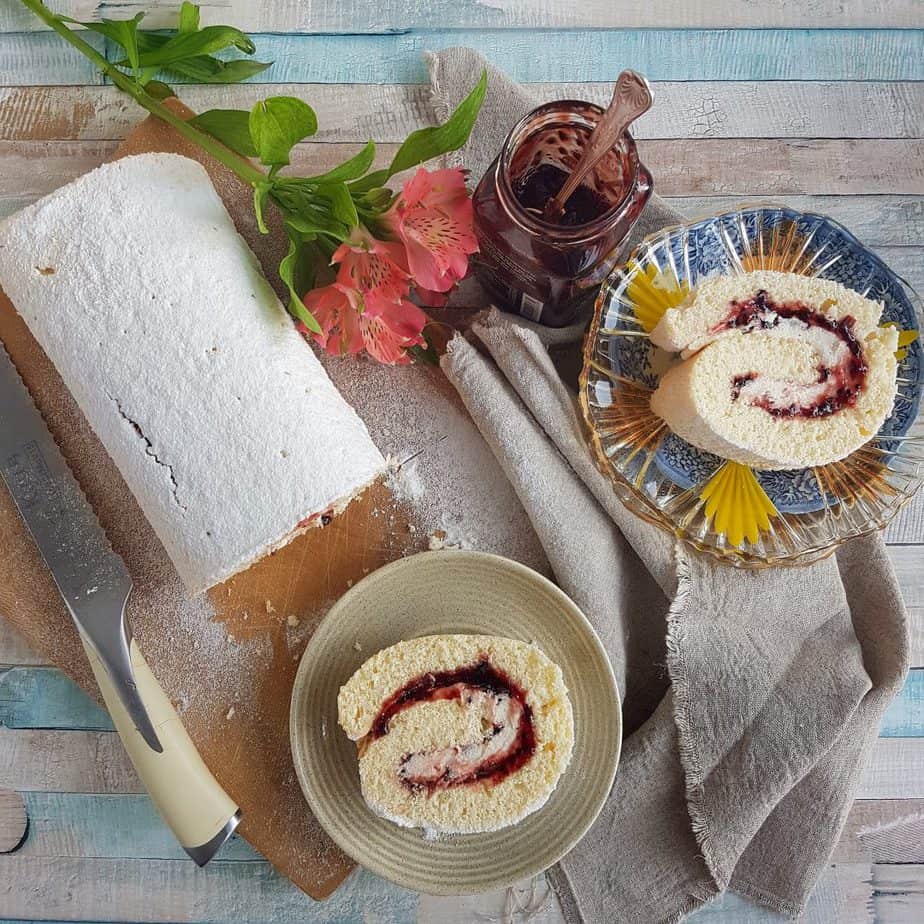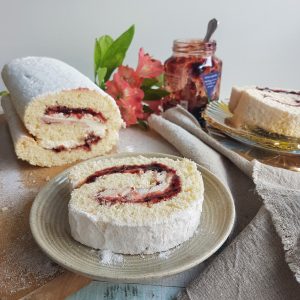How I conquered my fear of making Gluten Free Swiss Roll. I’ve been to my Mums for many a tea over the years where she’s produced a lovely gluten free Swiss Roll. I had always planned to make one myself one day but never quite had the bottle! The whole rolling of a thin sponge scared me, let alone attempting to roll a gluten free sponge.
Well I am thrilled to tell you dear reader that it really isn’t as bad as you think and if you put the following steps in place you will be a master roller in no time – trust me.
Swiss rolls can be made out of a basic vanilla sponge or a Genoise sponge, I favour the latter as it is lighter, feels and looks more luxurious and behaves better when it comes to the rolling.

A Basic Gluten and Dairy Free Genoise Sponge Recipe
I refer to this Genoise sponge in a lot of my recipes, it’s the perfect base sponge for my Best Ever Gluten Free Trifle! or this Best Gluten Free Tiramisu Dessert, birthday cakes, swiss rolls, gateaux….It NEVER fails and is so light and fluffy, no one will suspect it’s free from gluten or milk.
- 60 g gluten free plain flour
- 60 g gluten free self raising flour
- 130 g caster sugar
- 4 eggs separated
You will also preferably have a cake mixer (it is hard work on the elbows to make a Genoise), a swiss roll cake tin or medium baking tray, greaseproof paper and a clean tea towel – all will be revealed!



Can I make this swiss roll dairy free?
Yes you can make this swiss roll dairy free. In fact, a traditional Genoise sponge is already dairy free as no fat is used in the making of the sponge. The swiss roll then becomes dairy free or not depending on the fillings you chose to add.
What is the difference between a roulade and a Swiss roll?
Simply put, a Swiss Roll is always a thin sponge based cake that is covered in a sweet filling and rolled. A Roulade is rolled but doesn’t use sponge and can in fact be savoury. Example of a roulade are meringue, puff pastry, suet pastry or even meat or vegetables.

Subscribe today!
Sign up to my Friday Newsletter & receive 3 Free Downloads!
- GF & DF e-Book
- Conversion Guide
- 3 Guides to Dietary Needs
Do I need to use a special tin for this bake?
Do you need a special tin to make a swill roll sponge? The short answer is no. I use a supermarket bought medium-sized non stick baking sheet measuring 22x32cm*. The sides are approximately 2cm deep which is ample for a swiss roll sponge. I have also added an affiliate link to a purpose made swiss roll tin* if you’d rather.
How thick should a Swiss Roll sponge be?
Ideally you want it to be less than 2cm thick so that you can get a good tight curl effect and you’re not Ideally you want it to be less than 2cm thick so that you can get a good tight curl effect and you’re not heavy on the sponge. In situations where my sponge has risen unevenly I trim the bottom (inside) off after 5mins of cooling. That said, genoise sponge is quite amenable and will squash down if you ask it nicely!
Do you roll a Swiss roll hot or cold?
In the photo below you can see my swiss roll sponge all tucked up and looking ready for bed! I rolled this 5mins after removing from the oven and the tea towel you see it wrapped in was damp to start with. Due to the fact that the sponge has been rolled, it takes a little longer to cool down. I would recommend NOT allowing it to cool completely as you still want an element of flexibility when you unroll and re-roll.

Why is my Swiss roll cracking?
Your swiss roll may be cracking for one of two reasons. The first may be due to the fact that you baked it that little bit too long and the sponge is drier than necessary to get a good supple sponge. The second reason may be that you let the rolled sponge to cool for too long and unrolling it has compromise its structure. If this happens to you then fear not I have a couple of trick up my sleeve…
How do you fix a cracked Swiss roll?
There are a couple of things you can do to save a cracked swiss roll. One, you can dredge the final swiss roll in enough icing sugar to make a star angel in! Two, you could decide to decorate your swiss roll with any left over butter cream or drizzle melted chocolate over it to disguise any imperfections. One last suggestion would be to slice the roll in advance of anyone seeing it. Finally, let’s not be too hard on ourselves if this happens, it happens to me, and I’m sure Mary Berry has had it happen to her too.
How to roll a Swiss Roll
Step-by-step guide on how to roll a swiss roll:
- Remove from oven and cool for 5 mins before gently removing from tin and placing on a damp tea towel. I run my tea towel under a hot tap and wring out while the sponge is baking.
- The sponge will still be on it’s baking paper so remove this and place the sponge bottom side up onto the damp tea towel. The top golden side will be touching the damp cloth. Fold the end of tea towel over the short side of your sponge, gently begin to roll your sponge up away from you in a firm (but not too tight) roll.
- You will end up with a rather odd looking rolled up tea towel on your cooling rack with your Genoise sponge tucked up nice and warm inside!
- Leave the sponge rolled for at least 10 minutes.
- By now your sponge will have cooled to body temperature. Gently unroll and dollop spoonful’s of jam onto the bottom side (inner curl) of the sponge and smooth over the sponge with a pallet knife, this is actually the trickiest bit, covering the sponge with jam whilst the sponge tries to stay in a rolled up position.
- By now your sponge will have cooled enough to add the buttercream without it melting.
- To add your buttercream I strongly recommend using a piping bag, far less stressful and you won’t end up smearing the jam around too. I use a round nozzle and simply pipe tight ‘S’ shape lines of buttercream over the curled sponge until all the sponge is covered in an even layer of butter cream from end-to-end and edge-to-edge.
- Now here comes the fun part. Your sponge will already know where it’s going so gently re-roll the sponge being careful to not roll too tight causing your buttercream and jam to squeeze out of the sides.
- Place on a board or plate with the overlapped end downwards and dust with icing sugar.

Easy Dairy Free Butter Cream Recipe
Swiss Roll Butter Cream
250g icing sugar
150g unsalted butter (I use a plant based block of butter)
1 tsp vanilla essence
2 tsp boiling water
Simply add all the ingredients to a bowl and beat until pale and creamy.
TOP TIP: if you don’t have a piping bag, I would recommend spreading the butter cream onto the Swiss Roll first and then smoothing the jam on top, the reason for this is that I always find butter cream impossible to spread over jam and you end up with a jammy-creamy mess.

Filling Ideas for Swiss Rolls
In this recipe I’ve used a dairy free buttercream and jam filling. I’ve listed a few alternatives below that you might like to try, if you do I would love to hear how it went, of if you’ve tried anything different please let me know what and if you’d do it again?
Chocolate butter cream with marmalade instead of jam
Lemon butter cream with lemon curd
Vanilla butter cream with chocolate spread
In fact a Lemon Swiss Roll is the integral part of the official pudding for the Queen’s Platinum Jubilee a show stopping Lemon and Swiss Roll Amaretti Trifle
The competition was run by royal grocer Fortnum and Mason, in partnership with the Big Jubilee Lunch Charity, to create a pudding that had a memorable story behind it, tasted delicious, and was fit for the 96-year-old Queen.
BBC News
Gluten Free Swiss Roll Recipe
If you make it and like the recipe I would be eternally grateful if you popped back and commented leaving a star rating as this will tell search engines that this recipe is worth checking out and others will get to find it in searches.

Gluten Free Swiss Roll
Equipment
Ingredients
To make the Genoise sponge
- 60 g gluten free plain flour
- 60 g gluten free self raising flour
- 130 g caster sugar
- 4 egg(s) separated
To make the butter cream
- 250 g icing/confectioners sugar
- 150 g unsalted butter or dairy free alternative (I use Flora plant butter) I use Flora dairy free block
- 1 tsp vanilla extract
- 2 tbsp boiled water
Additional filling
- 4 tbsp jam I used a summer berry jam on this occasion
Instructions
- To start, sieve your flours together in a bowl, several times if you can be bothered. I've tried making this sponge with and without the sieving process and believe me it does make a difference.
- Add the egg whites to a mixer and using the whisk attachment beat into firm peaks.
- Add the caster sugar a table spoonful at a time and continue to beat until the whites become stiff and have a beautiful glossy sheen to them. TOP TIP: You know it's ready if you take a pinch a bit and rub your fingers together, if you can feel the sugar grains between your fingers you need to continue beating.
- Next add the egg yolks and whisk on slow, just enough to combine the two.
- Fold in the sifted flours quickly with a silicone spatula. Make sure you do this gently to prevent knocking too much air out of the mixture.
- Add to your well oiled and lined tin(s)
- Bake on 180°C | 160°C fan | 350°F | Gas 4 for 18-20 minutes – keep a close eye to make sure the sponge does not catch, you know this will be ready when you get a perfect spongy bounce to the touch….the cooked smell is unmistakable!
- Remove from oven and cool for 5 mins before gently removing from tin and placing on a damp tea towel (I run my tea towel under a hot tap and wring out while the sponge is baking.
- Gently peel off the baking paper. Now be brave and fold the end of tea towel over the short side of your sponge and gently begin to roll your sponge up away from you in a firm (but not too tight) roll. Your tea towel will roll up inside the sponge.
- You will end up with a rather odd looking fat rolled up tea towel on your cooling rack with your Genoise sponge tucked up nice and warm inside!
- Leave the sponge rolled for at least 10mins while you make your buttercream
To make the buttercream
- Simple add the butter or dairy free alternative to the clean mixing bowl along with the vanilla extract and boiled water and beat until light. Add the icing sugar in stages and beat for a prolonged period, the longer you beat the whiter and lighter the buttercream becomes.
To fill your Swiss Roll
- Gently unroll and dollop spoonful's of jam onto the bottom side (inner curl) of the sponge and smooth over the sponge with a pallet knife, this is actually the trickiest bit, covering the sponge with jam whilst the sponge tries to stay in a rolled up position.
- By now your sponge will have cooled enough to add the buttercream without it melting.
- To add your buttercream I strongly recommend using a piping bag, far less stressful and you won't end up smearing the jam around too. I use a round nozzle and simply pipe tight 'S' shape lines of buttercream over the curled sponge until all the sponge is covered in an even layer of butter cream from end-to-end and edge-to-edge.
- Now here comes the fun part. Your sponge will already know where it's going so gently re-roll the sponge being careful to not roll too tight causing your buttercream and jam to squeeze out of the sides.
- Place on a board or plate with the overlapped end downwards and dust with icing sugar.
- Breath a sigh of relief and make a well earned cup to tea to celebrate!
Nutrition
Click to find out more about the Free From Food Awards
I love to see your photos of my bakes, dinners and treats. Head to your favourite social media account and don’t forget to tag me in @glutarama so I can see them too!
Click to see gluten free products available on Amazon
Subscribe to my email list so that you get NEW recipes straight in your mailbox every Friday plus 3x FREEBIE’s and access to some amazing gluten free DISCOUNTS
*disclaimer: I use affiliate codes on my website, the vast majority are to Amazon. If you click on any of the links or images in the post and make a purchase my family will benefit from a small % of that purchase at no extra cost to you.
For full transparency, in 2020 I made my first £25, and in 2022 I reached my next £25 (Amazon don’t transfer the money until you reach £25). Recently I got paid a whopping £27.10 for 2023.
So to date I have made £78.58 since I first started the scheme in 2017. It won’t pay the bills, that’s for sure but it does help to pay for ingredients or little treats to cheer me up!

Gluten Free Small Business Guide
Updated on a regular basis, this guide champions small gluten free producers in the UK who deliver awesome free from bakes, cakes and savoury goods.




What flours are recommended?
Hello Kim I tend to use Doves Freee flour available in UK or Free From Fairy Flour (but add a little more liquid when using this wholegrain flour) thanks for commenting. Rebecca
Son diagnosed coeliac 8 years ago and said “mom all I wish for is a Swiss roll”!!!
I’ve searched for recipes to no avail. This was so straightforward and I thoroughly enjoyed making it!!
A very happy 15 Yr old!!
Thank you!
I absolutely loved reading this comment Claire, I’m thrilled to hear your son enjoy the Swiss Roll – this is why I do what I do xxx
I made this & after adding the flour I knew the consistency was wrong. The sponge was edible straight out of the oven but hard within hours. Gluten free baking generally requires less flour than regular recipes. I have since used a “regular” swiss roll receipe of 4 eggs, 120g sugar & 120g flour….this receipe has 260g of flour which is madness!!
Good heavens! you’re absolutely right Karen (apart from your maths, its 240g not 260g) I had a total mad moment and added 120g EACH knowing it was 120g IN TOTAL so 60g self raising and 60g plain. I am so sorry you wasted your time and ingredients on this recipe. I do hope you’re not put off trying other recipes on my site. Thank you for alerting me to this, I have now amended.
Please could you give the size of the swiss roll tin. It makes a big difference to the thickness and therefore the rolling
Sorry for the late reply to this Josephine, I’ve been out and about over the Easter break. I use a baking tray (no need for high sides) it’s 22x32cm. I’ll be sure to add this info to the recipe so others will know too. Thank you for your comment x